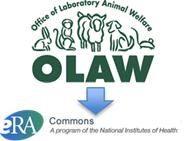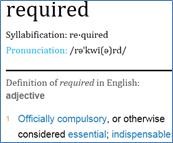eRA Commons Profile Animal Welfare Assurance Numbers to be Automatically Populated from OLAW Database
 In order for an institution to conduct animal activities supported by NIH grant funding, it must have an Assurance on file with the Office of Laboratory Animal Welfare (OLAW). For many years, OLAW has maintained a system to keep the negotiated assurances. That system, however, has never been linked with the eRA Commons institutional profile. Instead, Signing Officials (SOs) have had to manually enter assurance numbers in their institution profiles. Without any checks and balances to ensure the data is entered in the correct format and that it matches the information captured by OLAW, using the data in eRA Commons institution profiles has been problematic. How do we improve the accuracy of the profile information and the efficiency of our award processing? You guessed it – link the information between the two systems.
In order for an institution to conduct animal activities supported by NIH grant funding, it must have an Assurance on file with the Office of Laboratory Animal Welfare (OLAW). For many years, OLAW has maintained a system to keep the negotiated assurances. That system, however, has never been linked with the eRA Commons institutional profile. Instead, Signing Officials (SOs) have had to manually enter assurance numbers in their institution profiles. Without any checks and balances to ensure the data is entered in the correct format and that it matches the information captured by OLAW, using the data in eRA Commons institution profiles has been problematic. How do we improve the accuracy of the profile information and the efficiency of our award processing? You guessed it – link the information between the two systems.
The eRA team will release several changes with the April 16 software release related to assurance numbers. The eRA Commons institution profile will be updated to support multiple assurance numbers and will pull assurance number information directly from the OLAW database. If there is a discrepancy between the information on file with OLAW and the data entered in the institution profile, then both numbers will show in eRA Commons. SOs will no longer be responsible for entering the Animal Welfare Assurance Numbers in the institution profile; in fact, the field will no longer be editable in eRA Commons. Changes will need to go through OLAW.
In addition to the institution profile changes, a new business rule to warn applicants if the Animal Welfare Assurance Number on an application is not among those listed in their organization’s eRA Commons profile will be added to the validations done against incoming grant applications. This warning will help improve the accuracy of information associated with specific applications. To avoid the warning, applicants are encouraged to check their institution profiles and type the assurance number in their application exactly as it appears in the profile.
Later this year, OLAW will be changing their format for assurance numbers (they are running out of numbers). The University of Maryland – College Park (my alma mater – GO TERPS!) with a current assurance number of A3270-01, for example, will be issued a new number with the format ‘D15-xxxxx’ where ‘xxxxx’ is a unique, sequential number. With the eRA changes already in place, the transition to a new number format should be pretty straightforward. The new number will be automatically added to the institution profile and applicants will be asked to begin using their new assurance numbers on applications. A notice in the NIH Guide will be issued once the new assurance number format is implemented.
New PHS Additional Indirect Costs Form in Multi-project Applications
 Shortly after rolling out our solution for electronic multi-project applications, we identified an issue with our composite budget calculations. The premise of collecting budget data in the various components where the work is carried out and systematically rolling that data up to create the overall application budget is sound. However, without a budget form in the Overall component, we did not have a place for the applicant organization to apply the first $25,000 of a subawards total costs to their indirect cost base when that subaward was an entire component led by a collaborating organization.
Shortly after rolling out our solution for electronic multi-project applications, we identified an issue with our composite budget calculations. The premise of collecting budget data in the various components where the work is carried out and systematically rolling that data up to create the overall application budget is sound. However, without a budget form in the Overall component, we did not have a place for the applicant organization to apply the first $25,000 of a subawards total costs to their indirect cost base when that subaward was an entire component led by a collaborating organization.
You will now find an optional PHS Additional Indirect Costs form in the Overall component of all multi-project opportunities to address the data collection gap (NOT-OD-15-081).
The Multi-project Annotated Form Set has been updated to include the new form and the Electronic Multi-project Application Image Assembly document has been updated to include the adjustment to the composite application budget calculation.
Straight Talk About Application Requirements
 I manage a small support team called Grants Info responsible for responding to grant-related email and phone inquiries. Team members spend the better part of their day helping folks navigate through our many grant resources and matching ‘people who have questions’ with ‘people who have answers’. One of the most popular inquiries we receive is “What exactly do you mean by ‘required’?” This question can, of course, apply to any policy or guidance we put out. Most recently, it has been asked in the context of the new biosketch.
I manage a small support team called Grants Info responsible for responding to grant-related email and phone inquiries. Team members spend the better part of their day helping folks navigate through our many grant resources and matching ‘people who have questions’ with ‘people who have answers’. One of the most popular inquiries we receive is “What exactly do you mean by ‘required’?” This question can, of course, apply to any policy or guidance we put out. Most recently, it has been asked in the context of the new biosketch.
NIH expects applicants and grantees to follow all documented policies and instructions. When completing your grant application you must follow announcement clarification and policy notices posted in the NIH Guide, follow instructions in the Funding Opportunity Announcement and follow the guidance in the application guide and supplemental instructions. I know (better than most) that is easier said than done. The NIH puts out A LOT of grant information keeping my team very busy. J
So, when we say NIH “requires use of the new [biosketch] format for applications submitted for due dates on or after May 25, 2015” (NOT-OD-15-032), we mean…
All biosketches included in applications submitted for due dates on/after May 25, 2015 must be formatted per the instructions in the application guide (and repeated in online resources), including:
- Completing each section (A - Personal Statement; B – Positions and Honors; C – Contributions to Science; D – Research Support or Scholastic Performance)
- Including no more than 5 contributions to science with no more than 4 citations per contribution
- Ensuring that if you include the optional link to a full list of your published work in a site like My Bibliography that the URL is public, accessible without providing any login or personal information, and doesn’t link to websites that may violate page limit rules
- Refraining from including information, such as preliminary data, that belongs elsewhere in the application
- Following NIH guidance on font type, font size, paper size, and margins (See section 2.6 of application guide)
- Using PDF format for your biosketch attachments
- Limiting the length to 5 pages or less
The new biosketch policy is “required’ –officially compulsory, or otherwise considered essential; indispensable. Failure to follow the policy means NIH may withdraw your application from consideration (NOT-OD-15-095). The majority of the requirements listed above (all except the 5-page limit) would not be flagged until your application has already moved forward to NIH. If you don’t follow the instructions and our staff manually identifies a biosketch in your application as being non-compliant, then you won’t have the opportunity to correct it before the due date. In that context, is it really worth not following the instructions?
Personal Note & Thought for the Day
 My seemingly invincible dad, who just 6 months ago ran a 10K with his two adult grandsons, recently had emergency surgery. He is making a full recovery (phew!), but it got me to thinking about the amazing arsenal of tools and procedures available to the medical community today that didn’t exist just 10-20-30 years ago. It is nothing short of amazing how far we’ve come in such a short time. In the last 25 years, the proportion of older people with chronic disabilities has dropped by nearly one-third. That’s huge!
My seemingly invincible dad, who just 6 months ago ran a 10K with his two adult grandsons, recently had emergency surgery. He is making a full recovery (phew!), but it got me to thinking about the amazing arsenal of tools and procedures available to the medical community today that didn’t exist just 10-20-30 years ago. It is nothing short of amazing how far we’ve come in such a short time. In the last 25 years, the proportion of older people with chronic disabilities has dropped by nearly one-third. That’s huge!
I’ll never cure a disease or pioneer a new therapy, but I help folks navigate the NIH grant process and folks supported by NIH grant funding make amazing discoveries every day. It is pretty cool to play even a small part in the NIH mission.
Sheri Cummins
Communications & Outreach
NIH Office of Extramural Research
cumminss@mail.nih.gov




